Numerical integration (quadrature, cubature) in Python
Your one-stop shop for numerical integration in Python.
More than 1500 numerical integration schemes for
line segments,
circles,
disks,
triangles,
quadrilaterals,
spheres,
balls,
tetrahedra,
hexahedra,
wedges,
pyramids,
n-spheres,
n-balls,
n-cubes,
n-simplices,
the 1D half-space with weight functions exp(-r),
the 2D space with weight functions exp(-r),
the 3D space with weight functions exp(-r),
the nD space with weight functions exp(-r),
the 1D space with weight functions exp(-r2),
the 2D space with weight functions exp(-r2),
the 3D space with weight functions exp(-r2),
and
the nD space with weight functions exp(-r2),
for fast integration of real-, complex-, and vector-valued functions.
Install quadpy from PyPI with
pip install quadpy
See here on how to get a license.
Quadpy provides integration schemes for many different 1D, 2D, even nD domains.
To start off easy: If you’d numerically integrate any function over any given
1D interval, do
import numpy as npimport quadpydef f(x):return np.sin(x) - xval, err = quadpy.quad(f, 0.0, 6.0)
This is like
scipy
with the addition that quadpy handles complex-, vector-, matrix-valued integrands,
and “intervals” in spaces of arbitrary dimension.
To integrate over a triangle, do
import numpy as npimport quadpydef f(x):return np.sin(x[0]) * np.sin(x[1])triangle = np.array([[0.0, 0.0], [1.0, 0.0], [0.7, 0.5]])# get a "good" scheme of degree 10scheme = quadpy.t2.get_good_scheme(10)val = scheme.integrate(f, triangle)
Most domains have get_good_scheme(degree). If you would like to use a
particular scheme, you can pick one from the dictionary quadpy.t2.schemes.
All schemes have
scheme.pointsscheme.weightsscheme.degreescheme.sourcescheme.test_tolerancescheme.show()scheme.integrate(# ...)
and many have
scheme.points_symbolicscheme.weights_symbolic
You can explore schemes on the command line with, e.g.,
quadpy info s2 rabinowitz_richter_3
<quadrature scheme for S2>name: Rabinowitz-Richter 2source: Perfectly Symmetric Two-Dimensional Integration Formulas with Minimal Numbers of PointsPhilip Rabinowitz, Nira RichterMathematics of Computation, vol. 23, no. 108, pp. 765-779, 1969https://doi.org/10.1090/S0025-5718-1969-0258281-4degree: 9num points/weights: 21max/min weight ratio: 7.632e+01test tolerance: 9.417e-15point position: outsideall weights positive: True
Also try quadpy show!
quadpy is fully vectorized, so if you like to compute the integral of a function on many
domains at once, you can provide them all in one integrate() call, e.g.,
# shape (3, 5, 2), i.e., (corners, num_triangles, xy_coords)triangles = np.stack([[[0.0, 0.0], [1.0, 0.0], [0.0, 1.0]],[[1.2, 0.6], [1.3, 0.7], [1.4, 0.8]],[[26.0, 31.0], [24.0, 27.0], [33.0, 28]],[[0.1, 0.3], [0.4, 0.4], [0.7, 0.1]],[[8.6, 6.0], [9.4, 5.6], [7.5, 7.4]],],axis=-2,)
The same goes for functions with vectorized output, e.g.,
def f(x):return [np.sin(x[0]), np.sin(x[1])]
More examples under test/examples_test.py.
Read more about the dimensionality of the input/output arrays in the
wiki.
Advanced topics:
See
here
for how to generate Gauss formulas for your own weight functions.
Example:
import numpy as npimport quadpyscheme = quadpy.c1.gauss_patterson(5)scheme.show()val = scheme.integrate(lambda x: np.exp(x), [0.0, 1.0])
Example:
import quadpyscheme = quadpy.e1r.gauss_laguerre(5, alpha=0)scheme.show()val = scheme.integrate(lambda x: x**2)
Example:
import quadpyscheme = quadpy.e1r2.gauss_hermite(5)scheme.show()val = scheme.integrate(lambda x: x**2)
Example:
import numpy as npimport quadpyscheme = quadpy.u2.get_good_scheme(7)scheme.show()val = scheme.integrate(lambda x: np.exp(x[0]), [0.0, 0.0], 1.0)
Apart from the classical centroid, vertex, and seven-point schemes we have
Example:
import numpy as npimport quadpyscheme = quadpy.t2.get_good_scheme(12)scheme.show()val = scheme.integrate(lambda x: np.exp(x[0]), [[0.0, 0.0], [1.0, 0.0], [0.5, 0.7]])
Example:
import numpy as npimport quadpyscheme = quadpy.s2.get_good_scheme(6)scheme.show()val = scheme.integrate(lambda x: np.exp(x[0]), [0.0, 0.0], 1.0)
Example:
import numpy as npimport quadpyscheme = quadpy.c2.get_good_scheme(7)val = scheme.integrate(lambda x: np.exp(x[0]),[[[0.0, 0.0], [1.0, 0.0]], [[0.0, 1.0], [1.0, 1.0]]],)
The points are specified in an array of shape (2, 2, …) such that arr[0][0]
is the lower left corner, arr[1][1] the upper right. If your c2
has its sides aligned with the coordinate axes, you can use the convenience
function
quadpy.c2.rectangle_points([x0, x1], [y0, y1])
to generate the array.
Example:
import quadpyscheme = quadpy.e2r.get_good_scheme(5)scheme.show()val = scheme.integrate(lambda x: x[0] ** 2)
Example:
import quadpyscheme = quadpy.e2r2.get_good_scheme(3)scheme.show()val = scheme.integrate(lambda x: x[0] ** 2)
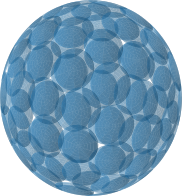
Example:
import numpy as npimport quadpyscheme = quadpy.u3.get_good_scheme(19)# scheme.show()val = scheme.integrate(lambda x: np.exp(x[0]), [0.0, 0.0, 0.0], 1.0)
Integration on the sphere can also be done for functions defined in spherical
coordinates:
import numpy as npimport quadpydef f(theta_phi):theta, phi = theta_phireturn np.sin(phi) ** 2 * np.sin(theta)scheme = quadpy.u3.get_good_scheme(19)val = scheme.integrate_spherical(f)
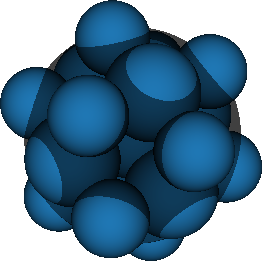
Example:
import numpy as npimport quadpyscheme = quadpy.s3.get_good_scheme(4)# scheme.show()val = scheme.integrate(lambda x: np.exp(x[0]), [0.0, 0.0, 0.0], 1.0)
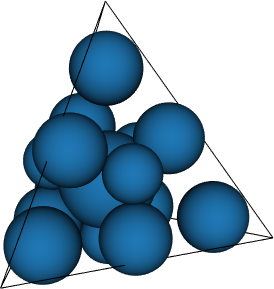
Example:
import numpy as npimport quadpyscheme = quadpy.t3.get_good_scheme(5)# scheme.show()val = scheme.integrate(lambda x: np.exp(x[0]),[[0.0, 0.0, 0.0], [1.0, 0.0, 0.0], [0.5, 0.7, 0.0], [0.3, 0.9, 1.0]],)
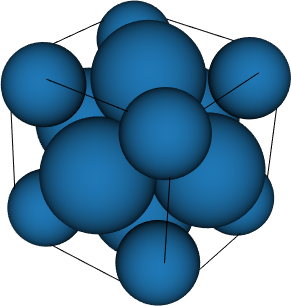
Example:
import numpy as npimport quadpyscheme = quadpy.c3.product(quadpy.c1.newton_cotes_closed(3))# scheme.show()val = scheme.integrate(lambda x: np.exp(x[0]),quadpy.c3.cube_points([0.0, 1.0], [-0.3, 0.4], [1.0, 2.1]),)
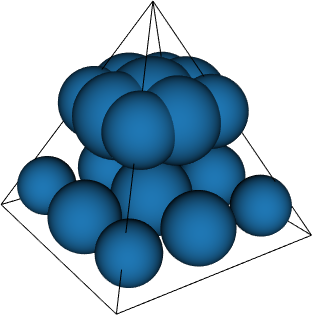
Example:
import numpy as npimport quadpyscheme = quadpy.p3.felippa_5()val = scheme.integrate(lambda x: np.exp(x[0]),[[0.0, 0.0, 0.0],[1.0, 0.0, 0.0],[0.5, 0.7, 0.0],[0.3, 0.9, 0.0],[0.0, 0.1, 1.0],],)
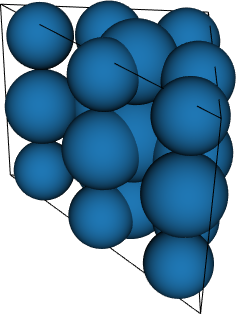
Example:
import numpy as npimport quadpyscheme = quadpy.w3.felippa_3()val = scheme.integrate(lambda x: np.exp(x[0]),[[[0.0, 0.0, 0.0], [1.0, 0.0, 0.0], [0.5, 0.7, 0.0]],[[0.0, 0.0, 1.0], [1.0, 0.0, 1.0], [0.5, 0.7, 1.0]],],)
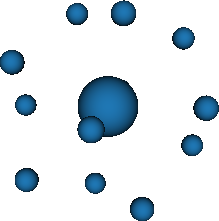
Example:
import quadpyscheme = quadpy.e3r.get_good_scheme(5)# scheme.show()val = scheme.integrate(lambda x: x[0] ** 2)
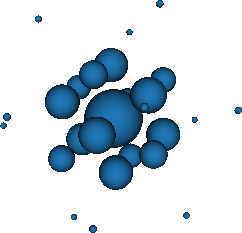
Example:
import quadpyscheme = quadpy.e3r2.get_good_scheme(6)# scheme.show()val = scheme.integrate(lambda x: x[0] ** 2)
Example:
import numpy as npimport quadpydim = 4scheme = quadpy.tn.grundmann_moeller(dim, 3)val = scheme.integrate(lambda x: np.exp(x[0]),np.array([[0.0, 0.0, 0.0, 0.0],[1.0, 2.0, 0.0, 0.0],[0.0, 1.0, 0.0, 0.0],[0.0, 3.0, 1.0, 0.0],[0.0, 0.0, 4.0, 1.0],]),)
Example:
import numpy as npimport quadpydim = 4scheme = quadpy.un.dobrodeev_1978(dim)val = scheme.integrate(lambda x: np.exp(x[0]), np.zeros(dim), 1.0)
Example:
import numpy as npimport quadpydim = 4scheme = quadpy.sn.dobrodeev_1970(dim)val = scheme.integrate(lambda x: np.exp(x[0]), np.zeros(dim), 1.0)
Example:
import numpy as npimport quadpydim = 4scheme = quadpy.cn.stroud_cn_3_3(dim)val = scheme.integrate(lambda x: np.exp(x[0]),quadpy.cn.ncube_points([0.0, 1.0], [0.1, 0.9], [-1.0, 1.0], [-1.0, -0.5]),)
Example:
import quadpydim = 4scheme = quadpy.enr.stroud_enr_5_4(dim)val = scheme.integrate(lambda x: x[0] ** 2)
Example:
import quadpydim = 4scheme = quadpy.enr2.stroud_enr2_5_2(dim)val = scheme.integrate(lambda x: x[0] ** 2)